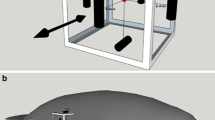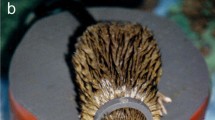Abstract
The capability of a blindfolded California sea lion (Zalophus californianus) to discriminate diameter differences of circular discs by means of active touch with its mystacial vibrissae was studied. Using a forced choice paradigm the sea lion was required to choose the larger of two simultaneously presented perspex discs. Absolute difference thresholds (ΔD) were determined for 3 standard discs (1.12 cm Ø, 2.52 cm Ø, 8.74 cm Ø) by the psychophysical method of constants. Increasing disc size resulted in an increase in the absolute difference threshold from 0.33 cm for the smallest disc size to 1.55 cm for the largest disc size. The relative difference threshold (Weber fraction) remained approximately constant at a mean value of 0.26. According to a video analysis the sea lion did not move its vibrissae when touching the discs. Instead, it performed precisely controlled lateral head movements, with the touched disc located centrally between the vibrissae of both sides of the muzzle. Since the extent of these head movements was identical at discs to be compared, discs of different size must have led to different degrees of deflection of vibrissae involved in the tactile process, resulting in quantitatively different mechanical stimulations of mechanoreceptors in the follicles. This suggests that the accuracy of the sea lion's size discrimination was determined by the efficiency of two sensory systems: the mechanosensitivity of follicle receptors as well as kinaesthesis.
Similar content being viewed by others
Abbreviations
- D :
-
starting stimulus size
- D i :
-
size of the interpolated comparison disc at 75% correct choices
- ΔD:
-
absolute difference threshold
References
Bryant PE (1968) Comments on the design of developmental studies of cross-modal matching and cross-modal transfer. Cortex 4:127–137
Carlson S, Tanila H, Linnankoski I, Pertovaara A, Kehr A (1989) Comparison of tactile discrimination ability of visually deprived and normal monkeys. Acta Physiol Scand 135:405–410
Carvell GE, Simons DJ (1990) Biometrie analysis of vibrissal tactile discrimination in the rat. J Neurosci 10 (8):2638–2648
Dehnhardt G (1990) Preliminary results from psychophysical studies on the tactile sensitivity in marine mammals. In: Thomas JA, Kastelein RA (eds) Sensory abilities of cetaceans. Plenum Press, New York, pp 435–446
Dietze AG (1961) Kinaesthetic discrimination: the difference limen for finger span. J Psych 51:165–168
Dykes RW (1972) What the seals vibrissae tell the seals brain. Proc Ann Conf Biological Sonar and Diving Mammals, 9th, Stanford Research Institut, Menlo Park, California, pp 123–136
Dykes RW (1975) Afferent fibres from mystacial vibrissae of cats and seals. J Neurophysiol 38:650–662
Fitzgerald O (1940) Discharges from the sensory organs of the cat's vibrissae and the modification in their activity by ions. J Physiol (Lond) 98:163–178
Gaydos HF (1958) Sensitivity in the judgement of size by fingerspan. Am J Psychol 71:557–562
Gellerman LW (1933) Chance orders of alternating stimuli in visual discrimination experiments. J Genet Psychol 42:206–208
Gescheider GA (1985) Psychophysics: Method, theory and application. Lawrence Erlbaum, Hillsdale New Jersey London
Gibson JJ (1962) Observations on active touch. Psych Rev 69 (6):477–491
Gottschaldt KM, Iggo A, Young DW (1973) Functional characteristics of mechanoreceptors in sinus hair follicles of the cat. J Physiol (Lond) 235:287–315
Guic-Robles E, Valdivieso C, Guajardo G (1989) Rats can learn a roughness discrimination using only their vibrissal system. Behav Brain Res 31:285–289
Hahn JF (1971) Stimulus-response relationships in first order sensory fibers from cat vibrissae. J Physiol (Lond) 213:215–226
Hunt CC, Mcintyre AK (1960) Properties of cutaneous touch receptors in cat. J Physiol (Lond) 153:88–98
Hyvärinen H (1989) Diving in darkness: Whiskers as sense organs of the Ringed seal (Phoca hispida). J Zool 218:663–678
John KT, Goodwin AW, Darian-Smith I (1989) Tactile discrimination of thickness. Exp Brain Res 78 (1):62–68
Kastelein RA, Gaalen MA van (1988) The sensitivity of the vibrissae of a pacific walrus (Odobenus rosmarus divergens) Part 1. Aquatic Mammals 14 (3):123–133
Krueger LE (1982) Tactual perception in historical perspective: David Katz's world of touch. In: Schiff W, Foulk E (eds) Tactual perception: A sourcebook. University Press, Cambridge, pp 1–53
Ladygina TF, Popov VV, Supin AYa (1985) Somatotopic projections in the cerebral cortex of the fur seal (Callorhinus ursinus). Academy of Siences Moskow 17 (3):344–351
Lamb GD (1983) Tactile discrimination of textured surfaces; psychophysical performance measurements in humans. J Physiol (Lond) 338:551–565
Ling JK (1977) Vibrissae of marine mammals. In: Harrison RJ (ed) Functional anatomy of marine mammals Vol III. Academic Press, London, pp 387–415
Mills F, Renouf D (1986) Determination of the vibration sensitivity of harbour seal (Phoca vitulina) vibrissae. J Exp Mar Biol Ecol 100:3–9
Pätzold N (1934) Über die Bedeutung des Zeitfaktors bei Tastwahrnehmungen. Z Sinnesphysiol 64:325–337
Renouf D (1979) Preliminary measurements of the sensitivity of the vibrissae of harbour seals (Phoca vitulina) to low frequency vibrations. J Zool Lond 188:443–450
Rensch B, Dücker G (1963) Haptisches Lern- und Unterscheidungsvermögen bei einem Waschbären. Z Tierpsychol 20:608–615
Semmes J, Mishkin M (1965) Somatosensory loss in monkeys after ipsilateral cortical ablation. J Neurophysiol 28:473–486
Sinclair RJ, Burton H (1991) Tactile discrimination of gratings: psychophysical and neural correlates in human and monkey. Somatosensory and Motor Res 8(3):241–248
Skramlik E von (1933) Über die Beeinflussung unserer Tastwahrnehmungen durch Richtung und Schnelligkeit der Tastbewegung. Z Sinnesphysiol 64:97–117
Stephens RJ, Beebe U, Poulter TC (1973) Innervation of the vibrissae of the California sea lion, Zalophus californianus. Anat Rec 176:421–442
Stevens SS, Stone G (1959) Finger span: ratio scale, category scale, and jnd scale. J Exp Psychol 57:91–95
Sur M, Nelson RJ, Kaas JH (1982) Representation of the body surface in cortical areas 3b and 1 of squirrel monkeys: Comparison with other primates. J Comp Neurol 211 (2): 177–192
Wartzok D, Ray GC (1976) A verification of weber's law for visual discrimination of disc sizes in the bering sea spotted seal, Phoca largha. Vision Res 16:819–822
Welker WJ, Seidenstein S (1959) Somatic sensory representation in the cerebral cortex of the racoon (Procyon lotor). J Comp Neurol 111:469–501
Wrobel K-H (1965) Bau und Bedeutung der Blutsinus in den Vibrissen von Tupaia glis. Zbl Vet Med A 12:888–899
Author information
Authors and Affiliations
Rights and permissions
About this article
Cite this article
Dehnhardt, G. Tactile size discrimination by a California sea lion (Zalophus californianus) using its mystacial vibrissae. J Comp Physiol A 175, 791–800 (1994). https://doi.org/10.1007/BF00191851
Accepted:
Issue Date:
DOI: https://doi.org/10.1007/BF00191851




